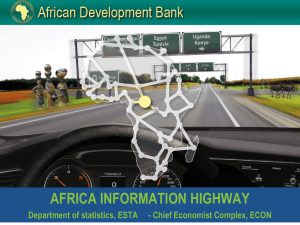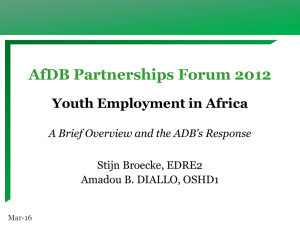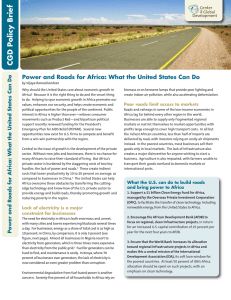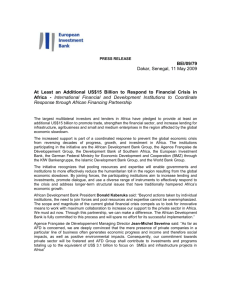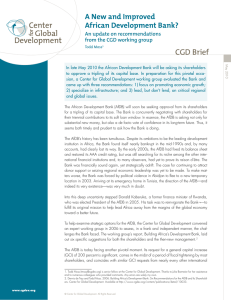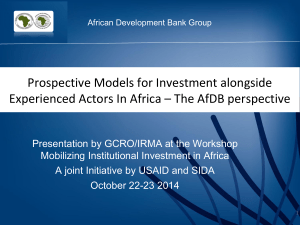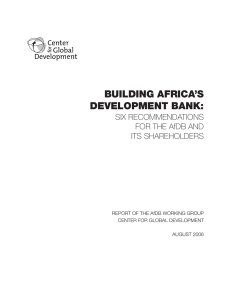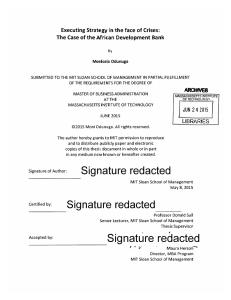Power Africa Initiative Brochure
advertisement
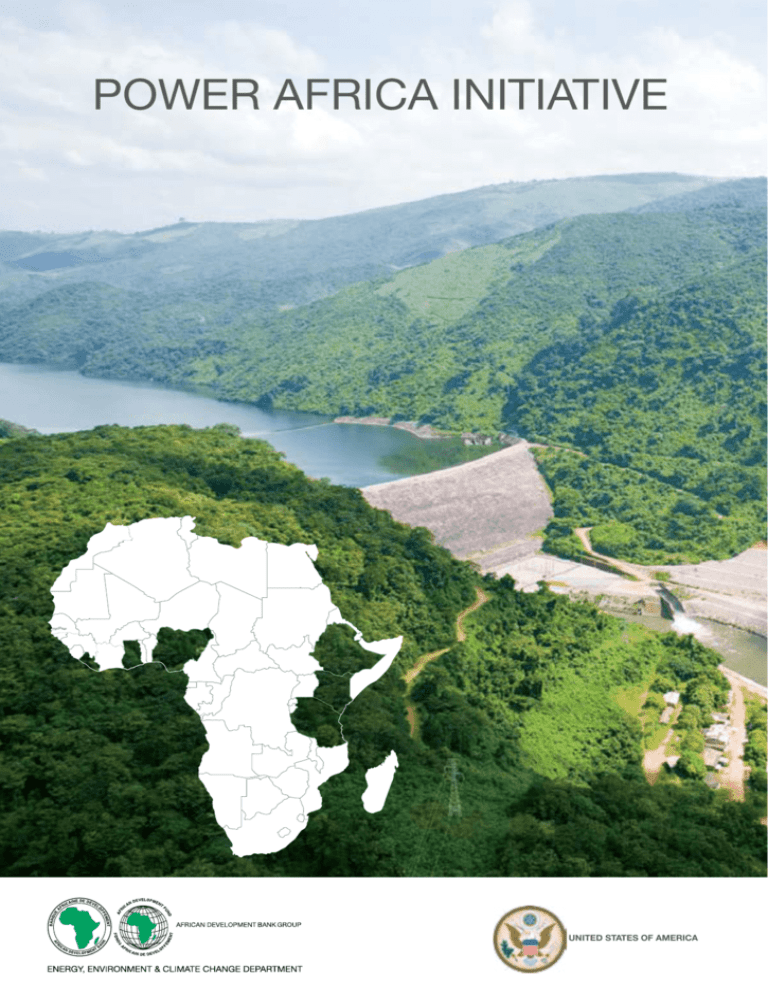
POWER AFRICA INITIATIVE UNITED STATES OF AMERICA SCALING-UP THE PARTNERSHIP ON POWERING AFRICA 1. Partnership Overview The United States of America (USA) became a member of the African Development Fund (ADF) in 1976 and of the African Development Bank (AfDB) in 1983. The USA supported the 2010 General Capital Increase VI and ADF XII replenishment of the African Development Bank Group. They pledged a total of about US $571.30 million for ADF XII, representing a 24 per cent increase from their ADF XI contribution. This year, the ADF is going through its 13th replenishment and the US is supporting enhanced funding for it. 2. Power Africa “Power Africa” is a new five-year United States of America Presidential initiative aimed at supporting economic growth and development by increasing access to reliable, affordable, and sustainable power in Africa. The program is designed as a multi-stakeholder partnership among the Governments of the United States of America, Tanzania, Kenya, Ethiopia, Ghana, Nigeria and Liberia, the US and African private sector, and the African Development Bank (AfDB). 3. New Collaboration Under Power Africa The AfDB seconded a staff member, Mr. Obiora Okoye, Senior Investment Officer of the Energy, Environment and Climate Change Department, to work with the United States Government (USG) Transaction Team in Washington DC for 2 months. He helped refine the Power Africa initiative and identify priority Power Africa projects - sharing in a direct way, the expertise of the AfDB and other multilateral development banks with USG policy makers. United States Agency for International Development (USAID) with close collaboration from the AfDB has taken the lead in shaping the list of priority Power Africa transactions across the six main focus countries. Criteria for selecting specific transactions include the potential to reach a major milestone within 18-24 months, amongst others. A good number of the identified transactions were sourced from committed and pipeline projects of the Bank such as the Lake Turkana Wind Farm in Kenya. Areas of collaboration include: a.Sustainable Energy Fund for Africa (SEFA) At the Launch of the Sustainable Energy For All (SE4All) Africa Hub held during the African Development Bank’s (AfDB) 2013 Annual Meetings in Marrakesh, USAID Assistant Administrator for Africa, Mr Earl Gast, announced that it will support the Bank hosted Sustainable Energy Fund for Africa as part of its long-term commitment to foster the growth of sustainable energy sources on the continent. SEFA is now in the process of transitioning into a multi-donor trust fund able to accept contributions from other donors. USAID made the initial $5 million pledge to SEFA as the first part of a multi-year commitment to the Fund. b.African Legal Support Facility (ALSF) The USAID has shown strong interest in supporting and scaling up the work of the ALSF housed at the Bank. In return, the ALSF will commit to providing contract negotiation assistance to Power Africa countries to help advance key transactions in the energy sectors. This will be accomplished through engaging specialized international legal counsel to work with national lawyers to advise the government during the negotiation of these agreements. These negotiations may include negotiating power purchase agreements, transmission and distribution agreements, licensing agreements, leasing agreements, and other related transactions. In addition, through coordination with the Initiative for Global Development (IGD), the ALSF will work to develop model agreements for future power projects. These agreements can serve as templates to help reduce transaction costs on future transactions. c.Partial Risk Guarantee Support (PRG) The Power Africa initiative has identified that risk mitigation products are essential for mobilizing private capital into power projects in Africa. In light of this, USG has expressed interest in working with the Bank to set up a Partial Risk Guarantee set-aside that will top up/co-guarantee with its existing ADF PRG instrument. Discussions are currently underway to further develop the idea and determine the appropriate mechanisms for channeling USG resources in support of the Bank’s guarantee program. f 4. AfDB MOBILIZING RESOURCES FOR POWER SECTOR DEVELOPMENT The AfDB has committed more than $1.65 billion in energy infrastructure funding to the six “Power Africa” priority countries over the past five years. Highlights from the Bank’s public and public-private partnerships energy active portfolio include: Map showing Public Sector Active Portfolio in 2012 5. A New Investment Vehicle: The Africa50Fund In May 2013 during its Annual Meetings, the African Development Bank unveiled plans for a new ‘Africa50Fund’, a big and bold solution designed to help fill the funding gaps in Africa’s transport, power, water and communications systems. The Africa50Fund will raise USD 10 billion in equity (in phases over time to seed the fund) which will be leveraged 10 times to deliver $100 billion worth of infrastructure projects. The Africa50Fund will establish two business lines: •Project Development, increasing the number of bankable infrastructure projects in Africa. •Project Finance, delivering the financial instruments required to attract additional infrastructure financing to the continent, including credit enhancement and other risk mitigation measures. In addition, the Africa50Fund will aim at reducing the timeline from project idea to financial close from a current average of 7 years to an intended 3 years, thus accelerating the pace of infrastructure delivery in the continent. Recognizing the critical role that private financing sources such as sovereign wealth funds, pension funds, and insurance can play in financing major energy projects in Africa, the African Development Bank together with USAID are collaborating to host a major event in Nigeria in October 2013. It is envisaged that the event will be held in partnership with the Nigerian Securities and Exchange Commission and will convene African Pension fund regulators, fund managers, private equity funds and other capital market stakeholders. 6. Conclusion The AfDB is an anchor partner of the USG’s Power Africa Initiative. This year, the African Development Fund is going through its 13th replenishment and a strong ADF replenishment would mean increased AfDB resources for catalytic public funding that can crowd in private energy investments in the six “Power Africa” countries. Contacts Kurt Lonsway Director OIC, Energy, Environnement and Climate Change Department k.lonsway@afdb.org Obiora Okoye Senior Investment Officer, Energy Division, Eastern and Southern Africa o.okoye@afdb.org
